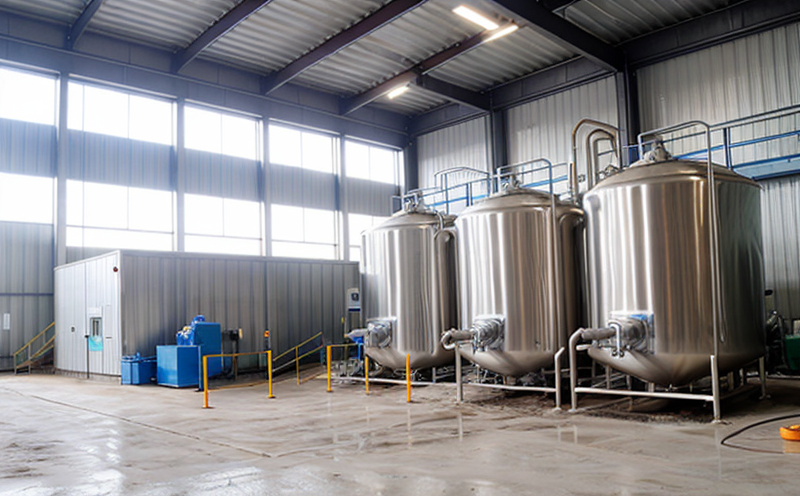EPA 8260 Volatile Organic Compounds VOC Test in Process Water
The EPA method 8260 is a widely recognized standard used for the extraction and quantification of volatile organic compounds (VOCs) from water samples. This method is particularly important in industrial process water testing, where ensuring that the water quality meets regulatory requirements and operational standards is critical.
During this test, the focus is on identifying and measuring VOCs present in the process water to ensure compliance with environmental protection regulations. The primary goal of this analysis is not only to detect the presence of these compounds but also to quantify them accurately so that appropriate corrective actions can be taken if necessary.
The process begins by collecting a representative sample of the industrial process water, which should ideally reflect the conditions under which it operates continuously or periodically. Once collected, the sample undergoes rigorous preparation steps aimed at preserving its integrity and ensuring accurate results. This may involve cooling, filtering, or adjusting pH levels depending on the nature of the VOCs being targeted.
The actual extraction phase uses either solvent-based techniques like purge-and-trap or direct injection into a gas chromatograph (GC). For this specific method, it’s essential to use solvents that can effectively dissolve the target compounds without causing interference with other components present in the matrix. After extraction, the concentrated VOCs are transferred onto appropriate media such as activated carbon cartridges for further analysis.
The next step involves analyzing these samples using gas chromatography-mass spectrometry (GC-MS), which provides high sensitivity and selectivity needed to identify even trace amounts of VOCs. GC-MS allows for precise determination of the types of VOCs present along with their concentrations, providing valuable insights into potential sources of contamination or operational inefficiencies within industrial processes.
After completing all analytical steps, comprehensive reports are generated detailing findings including names and quantities of detected VOCs, comparison against relevant standards like EPA Method 8260 itself as well as other applicable regulations such as ISO standards where appropriate. These reports serve multiple purposes from informing internal quality control measures to supporting external audits conducted by regulatory bodies.
By adhering strictly to the procedures outlined in EPA Method 8260, laboratories ensure they deliver reliable data capable of guiding decision-making processes related to maintaining safe and efficient industrial operations while complying with legal obligations towards environmental sustainability.
| Industry Sector | Potential Benefits from Testing |
|---|---|
| Chemical Manufacturing | Detects leaks and ensures proper handling of hazardous materials. |
| Mining Operations | Avoids accidents by identifying potentially flammable or toxic substances early. |
| Pharmaceutical Production | Guarantees product purity and adheres to strict quality control measures. |
| Petrochemical Processing | Prevents explosions by monitoring for volatile compounds that could ignite easily. |
Industry Applications
The EPA method 8260 VOC test in industrial process water has broad applicability across various industries. For instance, chemical manufacturers can benefit from early detection of leaks and proper handling practices for hazardous materials. In mining operations, this testing helps prevent accidents by identifying potentially flammable or toxic substances before they become problematic.
Pharmaceutical producers rely on accurate VOC measurements to maintain product purity and adhere strictly to quality control protocols. Petrochemical plants use these tests to monitor volatile compounds that could easily ignite under certain conditions, thus preventing explosions and ensuring safer working environments.
| Use Case | Description |
|---|---|
| Process Optimization | Detecting VOCs allows for fine-tuning processes to reduce waste and improve efficiency. |
| Regulatory Compliance | Ensuring compliance with local, national, or international standards on air emissions. |
| Environmental Monitoring | Tracking changes in VOC levels over time helps in understanding broader environmental impacts. |
| Risk Management | Identifying potential risks associated with VOCs aids in developing mitigation strategies. |
Competitive Advantage and Market Impact
Implementing EPA method 8260 testing can provide significant competitive advantages for companies operating in sectors that handle industrial process water. By leveraging this robust analytical approach, organizations demonstrate their commitment to maintaining stringent quality standards and ensuring operational safety.
This capability not only enhances customer trust but also positions firms favorably against competitors who may lack such advanced testing capabilities. Additionally, compliance with stringent environmental regulations can be seen as a selling point for potential clients seeking reliable partners committed to sustainable practices.
The ability to offer timely and accurate VOC test results also contributes positively towards brand reputation and market standing. Companies that invest in this service are likely to attract more business from environmentally conscious consumers or organizations prioritizing green initiatives.
Use Cases and Application Examples
The EPA method 8260 VOC test finds application in numerous scenarios within industrial settings. One common use case is during process optimization where detecting small traces of VOCs helps adjust procedures for better performance without compromising safety.
Another key example lies in regulatory compliance efforts aimed at meeting specific emission limits set forth by environmental protection authorities. By regularly monitoring VOC levels, facilities can ensure they remain within acceptable boundaries defined by relevant regulations such as EPA Method 8260.
Environmental monitoring programs also benefit greatly from this testing method since it provides valuable data about the presence and concentration of different VOCs over extended periods. This information is crucial for assessing long-term trends and identifying any emerging issues that require attention.





